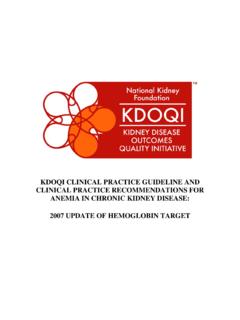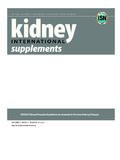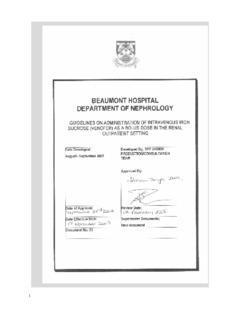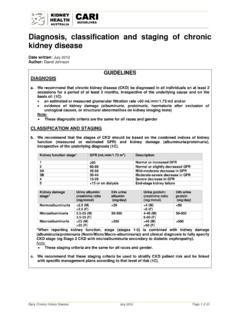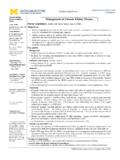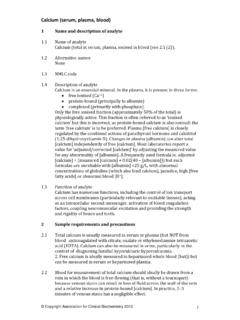Transcription of CANNT Vascular Access Guidelines 2015
1 Volume 25, Supplement 1 Nursing Recommendations for the Management of Vascular Access in Adult Hemodialysis Patients2015 UpdateClinicalEducatorsNetworkNursing Recommendations for the Management of Vascular Access in Adult Hemodialysis Patients 2015 Update 3 Nursing Recommendations for the Management of Vascular Access in Adult Hemodialysis Patients: 2015 UpdateTable of ConTenTs4 List of Figures, Flowcharts and Tables5 List of Acronyms and Abbreviations6 Message from the Co-chairs of the Canadian Hemodialysis Access Coordinators Network7 Preamble9 Vascular Access Guideline Working Group and Acknowledgements10 Chapter 1: Recommendations for New and Established Arteriovenous Access Management in Hemodialysis Patients 29 Chapter 2.
2 Recommendations for Central Venous Catheter Management in Hemodialysis Patients37 Identification of Research Opportunities37 Reference List44 Continuing Education Study Questions46 Continuing Education Study Answer Form4 Nursing Recommendations for the Management of Vascular Access in Adult Hemodialysis Patients 2015 UpdateList of Figures, Flowcharts and TablesFIGURES11 Figure 1: Vein preservation armband Ontario Renal Network (ORN) 11 Figure 2: Vein preservation wristband BC Renal Agency 11 Figure 3: Sample of CHAC Vein Preservation Wallet Card 14 Figure 4: Cannulation with a tourniquet 15 Figure 5: The Cushion Cannulation Technique 25 Figure 6: Two-digit Technique 30 Figure 7: I SAVE That Line FLOWCHARTS20 Flowchart 1: Complications of Cannulation 22 Flowchart 2: Cannulation of New AV Fistulas No CVC 24 Flowchart 3: Cannulation of New AV Fistulas with Existing CVC 36 Flowchart 4: Approach to Dysfunctional Hemodialysis CVC TABLES17 Table 1: Guidelines for Cannulation of AV Fistulas or AV Grafts 21 Table 2.
3 Rating Levels for Cannulation 34 Table 3: Steps for Accessing and De-accessing CVC 35 Table 4: Signs of CVC Dysfunction Assessment Phase 35 Table 5: Interdialytic Catheter Locking Solutions and Protocols Nursing Recommendations for the Management of Vascular Access in Adult Hemodialysis Patients 2015 Update 5 List of Acronyms and Abbreviations A-A Arterial arterial A-V Arterial venous AV Arteriovenous AVF Arteriovenous fistula AVG Arteriovenous graft BCPRA BC Provincial Renal Agency BH Buttonhole CNeph(C) Canadian Nurses Association Specialty Certification Certified in Nephrology Canada CANNT Canadian Association of Nephrology Nurses and Technologists CDC Centers for Disease Control and Prevention CEN clinical Educators Network CHAC Canadian Hemodialysis Access Coordinators Network CKD Chronic Kidney Disease CNNP Canadian Nephrology Nurse Practitioners Network CR-BSI Catheter-related bloodstream infection CSN-CPG Canadian Society of Nephrology clinical Practice Guideline CVAD Central venous Access device CVC Central venous catheter DOPPS
4 Dialysis Outcomes and Practice Patterns Study DVP Dynamic venous pressure EBPG European Best Practice Guidelines ESRD End-Stage Renal Disease eGFR Estimated Glomerular Filtration Rate HD Hemodialysis IV Intravenous Kt/V Dialysis Adequacy Calculation MN Master of Nursing MRSA Methicillin-resistant Staphylococcus Aureus NKF-KDOQI National Kidney Foundation Kidney Disease Outcomes Quality Initiative NS Normal saline NP Nurse Practitioner ORN Ontario Renal Network Pa Arterial pressure Qa Access flow Qb Blood flow RN Registered Nurse RNAO Registered Nurses Association of Ontario URR Urea Reduction Ratio VA Vascular Access VAC Vascular Access Coordinators VP Venous pressure V-A Venous arterial V-V Venous arterial6 Nursing Recommendations for the Management of Vascular Access in Adult Hemodialysis Patients 2015 UpdateMessage from the Co-chairs of the Canadian Hemodialysis Access Coordinators NetworkThis document represents an updated version of a project that was initially undertaken in 2006 by members of the Greater Toronto Area clinical
5 Educators Network (CEN) and the Canadian Hemodialysis Access Coordinators Network (CHAC). This year, the document was revised by the members of CHAC, CEN and Canadian Nephrology Nurse Practitioners (CNNP) groups. Recognizing the ongoing, commonly faced challenges in nursing prac-tice across the country related to Vascular Access in adult hemodialysis patients, the working group identified the need for collaboration and sharing of experiences and expertise, specifically in the management of new and established arteriovenous accesses and central venous catheters.
6 These recommendations are offered as clinical practice Guidelines , rather than standards of practice, and are based on evidence and evidence-based practice where it exists. Some topics offer little or no published literature, or conflicting information and, in those instances, comments are based on evidence-informed opinion and are included in the document as clinical hope is that these Guidelines will assist hemodialysis nurses in the care and management of Vascular Access , assist in preparing unit policies and protocols, and provide clinicians with education and documentation tools.
7 Furthermore, it is hoped that the Guidelines will encourage and inspire nursing research that will enhance the body of existing literature in the interest of improving outcomes for adult patients on hemodialysis. Patty Quinan, RN, MN, CNeph(C), and Kelly Sutherland, RN Co-chairs of the Canadian Hemodialysis Access Network (CHAC) Correspondence to:Patty Quinan, RN, MN, CNeph (C) Kelly Sutherland, RN, CNeph (C)Humber River Hospital, St. Joseph s Hospital, Toronto, ON, Canada Hamilton, ON, CanadaEmail: Email: Nursing Recommendations for the Management of Vascular Access in Adult Hemodialysis Patients 2015 Update 7 PREAMBLEM embers of the Canadian Hemodialysis Access Coordinators Network (CHAC), clinical Renal Educators and Canadian Nephrology Nurse Practitioners (CNNP) groups collaborated to establish nursing recommen-dations for the management of new and established arteriovenous (AV) accesses and hemodialysis central venous catheters (CVC).
8 The term group or working group refers to the above-mentioned members. The term hemodialysis and dialysis will be used interchangeably throughout this document to refer to hemodialysis (HD) treatment, not peritoneal dialysis. The term nurse refers to registered nurses and registered practical nurses with formal theoretical and practical hemodialysis knowledge and document includes recommendations and Guidelines intended to assist clinicians in the treatment and management of Vascular Access for individual dialysis units and nephrology programs.
9 These Guidelines apply to Vascular Access care and management for adult HD patients, and may not be applicable for pediatric HD patients (under the age of 18 years).The working group recommends that these Guidelines are revised every five Nursing Recommendations for the Management of Vascular Access in Adult Hemodialysis Patients 2015 UpdateNursing TerminologyClinical practice guidelinesIt is the opinion of the working group that recommendations for the care and management of Vascular accesses for adult hemodialysis patients are based on research (where it exists)
10 , published Guidelines , or evidence-based practice ( , Canadian Society of Nephrology clinical Practice Guidelines for Vascular Access , [Jindal et al., 2006]; National Kidney Foundation-Kidney Disease Outcomes Quality Initiative [NKF-KDOQI] Guidelines for Vascular Access update [NKF, 2006].)Evidence-based practiceEvidence-based practice within the context of nursing is a prob-lem-solving approach to the delivery of health care that integrates the best evidence from well-designed studies and patient care data, and combines it with clinical expertise and patient preferences and values (Melnyk, Fineout-Overholt, Stillwell & Williamson, 2010, p.)
